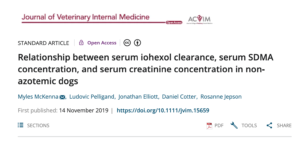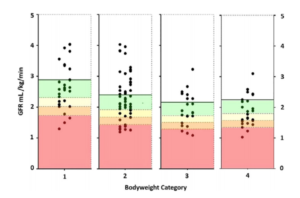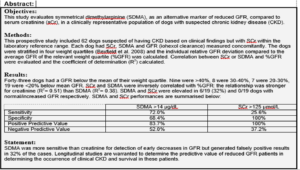Below are a few examples of works which we have been involved with, alongside our academic collaborators:
The relationship between GFR, SDMA, and serum creatinine in a population of client‐owned dogs

Symmetric Dimethylarginine (SDMA) and serum creatinine are used as surrogate markers of glomerular filtration rate (GFR) in clinical practice. There is little data comparing the GFR, SDMA and creatinine measures in dogs. In a 5 year study of 119 dogs for which GFR had been performed via serum Iohexol cxlearance between 2012 and 2017. This paper describes the relationship between GFR, SDMA, and serum creatinine in a population of client‐owned dogs, and compares the clinical utility of SDMA to GFR estimation for detecting pre‐azotemic chronic kidney disease.
To down this paper for free please visit the Wiley Online Library at:
https://onlinelibrary.wiley.com/doi/full/10.1111/jvim.15659
Estimation of glomerular filtration rate in dogs shown to have clinical utility in diagnosing Chronic Kidney Disease before the onset of azotemia
 Based on a collaboration which started in 2012 between deltaDOT and the Royal Veterinary College using deltaDOT’s High Performance Capillary Electrophoresis instrument, it has been shown that the measurement of glomerular filtration rate (GFR) of dogs kidneys has significant clinical utility. To access the publication please click the link below:
Based on a collaboration which started in 2012 between deltaDOT and the Royal Veterinary College using deltaDOT’s High Performance Capillary Electrophoresis instrument, it has been shown that the measurement of glomerular filtration rate (GFR) of dogs kidneys has significant clinical utility. To access the publication please click the link below:
https://www.ncbi.nlm.nih.gov/pubmed/31373414
Validation of a High Performance Electrophoresis Method for Measurement of Glomerular Filtration Rate by Serum Iohexol Clearance in Dogs
L Pelligand1, S Willians1,2, J Elliott2, 1Royal Veterinary College, London UK; 2deltaDot, London UK
Glomerular filtration rate (GFR) is generally considered to be the gold standard measurement of kidney function. GFR can be calculated by measuring serum iohexol clearance using concentrations at 2,3 and 4 hours following a bolus injection.
For validation, serum samples were spiked at low (0.017 mg/mL), medium (0.27 mg/mL) and high (2.16 mg/mL) iohexol concentrations. They were analysed, along with standard calibration curves (8 concentrations ranging from 0.017 to 2.16 mg/mL), using deltaDOT’s Label-Free high performance capillary electrophoresis (HPCE) system. Data were analysed using deltaDOT’s General Separation Transform (GST). Clinical and spiked serum samples were also sent for analysis by mass spectrometry (MS) at a reference laboratory (14 samples for comparison). Concentrations obtained by HPCE and MS were compared in a Bland Altman plot. GFR for clinical samples was calculated from the measured iohexol concentrations using the method reported by Bexfield (2008).
A validated method was produced, with a lower limit of detection of 0.009 mg/mL and an lower limit of quantification of 0.017 mg/mL. The upper limit of quantification was 2.16 mg/mL. The standard curve had excellent linearity (R2 = 0.993). Maximum inaccuracy was less than 11.5% of the true value, except at LLOQ, where it was within 24.2%. Average within day variability was less than 13.1% at all levels, while between day variability was less than 5.6%, except at LLOQ, where it was less than 15.4%. Agreement between the results obtained by measurement with HPCE and MS was good (bias 1.3%, lower and upper limits of agreement of -15.4 and 18.0%, respectively). Method specificity was confirmed by the absence of matrix effect in six serum specimen obtained from clinical dogs. Clinical samples were analysed and GFR reported with a 3 day turnaround time.
In conclusion, HPCE provides an accurate and precise method for measuring iohexol in canine serum.
Assessment of renal function in dogs and cats –what’s new?
Dr. L. Pelligand
Senior Lecturer in Veterinary Pharmacology and Anaesthesia
DMV, Cert. VA, Dipl. ECVAA, Dipl. ECVPT, PhD, MRCVS
Early detection of kidney disease in dogs: a comparison of serum SDMA and Creatinine versus GFR measured by Iohexol clearance

